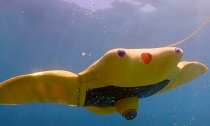
Soft-body submersibles designed to resemble and move like manta rays have been developed by a team at the School of Navigation of Northwestern Polytechnical University in Xi’an, the capital of Shaanxi Province in central China, for monitoring coral reefs. The R&D team began developing submersibles for coral reef monitoring in 2006, by studying the swimming patterns of marine organisms for their prototypes.
More recently, they have monitored outbreaks of species such as the crown-of-thorns starfish, which pose a threat to coral reefs by feeding on them in the South China Sea.
The team’s smaller submersibles are utilized for marine education and coral reef monitoring, while their larger models can dive deeper and for longer periods to collect more data.
Many people are curious whether bionic submersibles, including manta ray-like soft-body submersibles, are in danger of being eaten by sharks in the ocean.
Cao Yong, a professor at Northwestern Polytechnical University, said: “Under normal circumstances, the working scene of small submersibles is under control. The large one has a wingspan of more than 4 meters. Typically, sharks will not touch it. But younger whales are more playful and may use their tails to damage it. To mitigate this, we will warn or drive away (the whale) through some sound. In fact, the microorganisms can cause some problems. If there are too many attachments, it will affect its navigation. At present, we apply a layer of hydrogel on its surface, which can avoid the attachment of these microorganisms.”

The soft-body submersibles have been designed to resemble manta rays. /CMG














Social Profiles